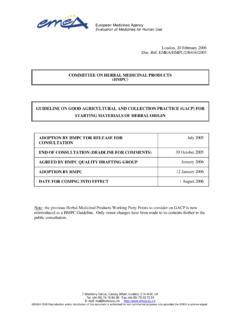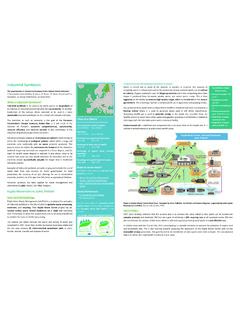Transcription of CHAPTER 8 LABOR AND MANAGEMENT: FARM LABOR …
1 CHAPTER 8. LABOR AND management : farm LABOR AND RELATED SERVICES. LABOR is one of the most important inputs in agricultural production. How it is measured and valued is critical for establishing the cost of producing agricultural commodities and accurately portraying LABOR 's relative share of the total cost of production. Historically, in agricultural commodity cost and return (CAR). methods, LABOR and management have been treated as distinct, unrelated, or disconnected inputs. A variety of reasons undoubtedly exists for this separation. The perspective that leads to a separation of LABOR and management , however, is not useful to clear thinking about CAR estimates because human capital, including allocative ability, and human time of an individual are inseparable and jointly allocated (Huffman, 1985). Two major categories of farm LABOR are proposed: (1) hired LABOR without farm ownership claims, and (2) unpaid farm LABOR and salaried farm LABOR having ownership claims.
2 A comprehensive accounting procedure is recommended for the farm LABOR input in ways that will most likely increase recognition of the quantity of unpaid farm LABOR used in farming. The cost of hired farm LABOR (type 1 farm LABOR ) is total producers' costs, including wages, salaries, fringe benefits, and other hired LABOR associated costs. Several alternative methods for valuing unpaid farm LABOR and salaried farm LABOR having ownership claims are evaluated, including the most preferred opportunity cost method. The particular opportunity cost is the off- farm wage, paying careful attention to point-in-time availability or use and quality dimensions (for example, years of schooling completed, years of postschooling experience) and local economic conditions (high or low structural unemployment rates, unusually attractive or unattractive local amenities, and unusually high or low trend growth of employment).
3 Thus, the cost of a farm operator's LABOR in farming can be forecast from a wage equation, given the operator's characteristics, and local economic conditions. We suggest procedures for producing and distributing this information. The recommended procedures for farm LABOR and related services will lead, in general, to higher estimated costs of operators' unpaid farm LABOR than procedures that use the average local wage rate for hired farm LABOR as the cost and use engineering estimates of LABOR use. Higher costs occur because in most situations both the per unit cost and total number of units of LABOR will increase. TERMS AND DEFINITIONS. Laborers or workers are defined as the number or inventory of persons at a point in time. Workers are generally heterogenous because of differences in productive skills, location, and availability for work. LABOR is a service (person-years per year) and includes all human time-using activities, including what is sometimes labeled separately as LABOR and management .
4 LABOR services are perishable and hence cannot be moved to another period in time for use; workers, on the other hand, are durable, potentially working for many years as well as being geographically mobile. 8-1. CHAPTER 8. LABOR and management : farm LABOR and Related Services farm LABOR includes all hired, contract, exchange, and unpaid family LABOR used in agricultural production. farm LABOR is defined here to encompass what is sometimes distinguished as traditional LABOR , management , and other overhead time, and also includes LABOR acquired through farm LABOR contractors and all semiskilled services used in farming, such as mechanics for machinery and building repair, and bookkeepers. A broad definition of LABOR and related services makes for a relatively homogenous input category over time, as specialization and change in the economic organization of farms and of our economy occur. All units of farm LABOR are not assumed, however, to be the same with respect to skill, location, and availability or period of use.
5 Suggestions that hired LABOR is a fixed input are not compelling, except in the very short run. Even when a farmer makes a contract for a month (or year) with a worker for a certain number of hours of LABOR , there is generally considerable flexibility about exactly when and what work is done. Thus, LABOR that might sometimes seem to be "fixed" is really "variable.". Services of highly skilled professionals such as lawyers, tax accountants, and veterinarians are not included in the definition of farm LABOR and related services because these individuals possess skills from human capital investments and specialization that are very different from the skills possessed by farmers and ranchers. As a result, these services are not "close" substitutes for farm LABOR as defined here. Costs associated with the services provided by such skilled professionals should be reflected in other input expense categories.
6 OPPORTUNITY COST OF farm LABOR . The opportunity cost of farm LABOR is the maximum value per unit among the alternative uses of that LABOR . Skill or human capital, location, and period of use are generally important factors for determining the opportunity cost of farm LABOR . For hired farm LABOR (no ownership claim), the compensation (wage plus cost of benefits) is the opportunity cost. Though unpaid farm LABOR does not generally receive a wage, it does have an economic cost. Implicit compensation for unpaid farm LABOR is based on the opportunity cost of off- farm work, or the return available in the next best alternative use of this LABOR time and effort. As long as adjustments are made for LABOR quality or effective LABOR units so that implicit wages measure effective LABOR market skills, cost of production estimates will not be affected greatly by whether hired or unpaid LABOR is employed in farming or nonfarming enterprises.
7 To the extent that there are specific human capital skills or experience associated with particular agricultural enterprises, there may be minor differences between the opportunity wage of an individual working on a particular farm , on another farm , or in the nonfarm sector. When farming enterprises differ in their technologies and, at the same relative input prices, have different LABOR intensities of production, the decision maker who sets the price of LABOR "too low" is giving (at least on paper) an absolute and relative cost/profit advantage to the most LABOR -intensive enterprise(s). This means that both absolute and relative marginal costs of production will be distorted, resulting in nonoptimal allocation decisions. Note that for a given farm , "homogeneous" LABOR will have the same cost across all farming enterprises. 8-2. CHAPTER 8. LABOR and management : farm LABOR and Related Services QUANTITY OF farm LABOR .
8 Measuring LABOR as the number of workers or employees is using a stock item to approximate a service. All workers generally do not work the same number of hours per period and are different in ways that affect the quality of a unit of service. Thus, approximating farm LABOR by the number of workers or by assuming a uniform rate of conversion from stock to flow, such as eight hours per day, is not a recommended practice. Measuring farm LABOR as person-hours per period used in farming is the appropriate services measure. Homogenous LABOR can be aggregated by adding together hours in the same period. Surveys of LABOR availability and possibly time-and-motion studies can provide the details needed for good LABOR quantity measures. Heterogenous LABOR should not simply be added together to obtain an aggregate because if the LABOR is available in different periods, intertemporal transfer is generally impossible and it is costly to change the skills or geographic location of workers.
9 Thus, measuring available farm LABOR or farm LABOR use by adding up annual hours of work is not a generally recommended practice. When heterogenous farm LABOR must be aggregated, an index created as the price-weighted hours has major advantages. In this approach, hours of LABOR provided at a higher price receive a greater weight than those associated with a lower price. This practice reflects the fact that opportunity costs are greater for higher-priced LABOR . A price-weighted LABOR index can be thought of as being expressed in efficiency units. Although two farms may be using the same physical units of farm LABOR , one of them may have more "effective" LABOR because it is using higher-quality LABOR . As an example, a dairy farm employee responsible for bST injections, artificial insemination (AI), and supervision of dairy parlor operations may receive a much higher wage than an individual who milks cows or fills feed bunks.
10 Similarly, the cost per hour for individuals to pick apples may be higher during some periods than others. The choice between alternative methods to estimate the quantity of farm LABOR is influenced by the type of information available and the purpose of the estimation. Accurate farm LABOR data are frequently difficult to obtain. One approach is to estimate LABOR hours from input-output relationships, engineering coefficients, or LABOR requirement data. For example, in the Upper Midwest Dairy farm example, Tables contain machine use coefficients that are sometimes used to generate LABOR use (for example, 100 hours of field cultivation requires 100 hours of LABOR and 100 hours of machine services). farm LABOR data created from this method tend to underestimate "true" LABOR use, even for these machine operations, unless they are specifically calibrated to LABOR surveys. The use of LABOR coefficients often ignores important LABOR quality differences.
















